"There are nobles and seamen in the Reikland fleet; but, the seamen are not very noble, and the nobles are certainly no seamen."
- —Lord Tyrkel Von Hargelfels, Admiral of the Nordland fleet
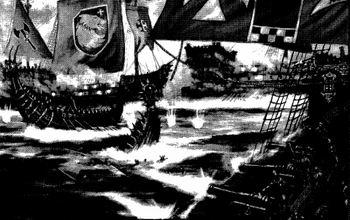
The mighty Wolfships of the Imperial Navy
The Imperial Navy, also known as the Empire Fleet is one of the most important military assets of The Empire. Characterised by its fast moving ramships and its mighty and heavily-armed Greatships, the Imperial Navy of the Empire is one of the most powerful fleets patrolling the waters of the Old World.[1a] To the north, a new fleet has arisen in Nordland and is well financed, well-trained, and well armed, but it is under constant threat from Norse marauders, pirates, and very dangerous waters.[2a]
To the south, the old fleet of the Reikland may be far larger, but it is mostly a river-based force led by captains with little sea-faring experience, for their ships rarely pass Marienburg due to prohibitive treaties and extortionate tolls. But no matter how curtailed it may be, the Imperial Navy is enormous. It employs countless men and women, and funds entire settlements. Not only this, but it provides real opportunities for both the rich and the poor. Indeed, it is one of the only institutions where nobles and commoners not only rub shoulders, but often mix. Whether you are a soldier or sailor, a craftsman or cook, a weaver or gunner, an engineer or armourer, the Imperial Navy needs you.[2a]
History
The first military ships of the Empire were reputedly built over two thousand years ago in response to Norse raids in the north. The Norse tribesmen were expert shipbuilders, and frequently crossed the Sea of Claws to make forays along the Empire’s coasts, looting, pillaging, and murdering. According to the Chronicles of the Venerable Ottokar, the local nobles were “powerless against the blasphemous Norse,” for whenever they brought an army to bear against them, they fled to their vessels like the Godless cowards they were, then sailed down the coast to attack elsewhere.[2a]
The Birth of the Imperial Fleet (1 to 700 IC)
"They boasted of fourteen so-called "Keepers of the Coast". They claimed each stood vigil in the summer with their boats and militias. They said each were recruited and trained during the winter. I do not believe it. I saw those "boats". They were no better than a pile of logs thrown to the ground by a troll."
- —Saga of Damrik Ulgriksson
Because the Empire had no method of its own to transport troops along the coastlines or across rivers, the Norse had the freedom of the Empire’s coastlines. In an attempt to curtail this, the desperate nobles ordered great boats be built, so Westerland may be proud again in Sigmar’s grace. The order succeeded, for not long after there were boats from point to point with great men within, bone-cages wrapped in battle coats, arms bright with weapons of war. So successful was this early ship-building, local Dukes and Counts demanded their coastal Barons all build a ship for the transport of men as part of their feudal obligations. It seems the added manoeuvrability this provided defence militias was significant, for they did smite the Norse like Sigmar to the unholy. However, this was considered not enough.[2a]
In 632 IC, the Norse sacked Marienburg, capital of Westerland. According to Sigmarite records, the Emperor himself demanded action be taken. After prolonged discussions with the Baron of Westerland, a new title was created and with Sigmar’s wisdom, he did order the Keepers of the Coast be made truth in law. It seems these new nobles were tasked with building ships and assembling men to crew them. Further, they were to establish coastal patrols and watch-fires, organise routes of escape, and build fortifications to defend when invasions are too large to bear. It took time, but it seems by the mid 700s IC, the standing navy of the Empire had spread along the western and northern coasts.[2a]
After some time, it became apparent that the newly formed fleets have made some form of difference, for in 765 IC, The Baron of Westerland concluded treaties with representatives of the Norse Sarl, Skaeling, and Bjornling tribes at the Althing of Traktatsey, effectively ending hostilities. After three generations, the Keepers of the Coast eventually became a largely ceremonial title in nature.[2a]
The Dragon and the Wolf (700 to 1111 IC)
"Fyrthur knelt before the Father, and he saw the goodness that was Sigmar, and he said unto him: Yes, I have seen the truth, I will teach you how we build our dragons."
- —Sigmarite records now held in Salzenmund
Perhaps this was a mistake, for, in what would become a recurrent cycle, the Norse eventually took advantage of the Empire’s lowered defences and resumed raiding again, sacking Marienburg for a second time in 1109 IC. If not for the Black Plague of 1111 IC, it is possible the Norse would have kept the city. Whatever may have been, for the next two centuries, civil issues in the heart of the Empire left the coastal provinces to fend for themselves. Although the navy never fully died during this time, it was far from fit for purpose. Many records show how Nordland was repeatedly raided and settled, and chronicles from Ostland and Westerland suggest they fared little better; however, the permanent arrival of the Norse did have one advantage. In time, those Norse that settled within the Empire has taken up the Sigmarite faith and taught the Empire the secrets of making the fearsome Wolfships and Dragonships of the Norse raiders.[2b]
However, as advances were being made in the north, civil war broke out in the south. By 1360 IC, there were two Emperors, by 1547 IC there were three. During this time, the navies of Nordland, Ostland, Middenland, Reikland, and Westerland rose to prominence, especially those of Reikland and Westerland. Putting Norse shipbuilding skills to good use, quality ships were soon plying most of the rivers and coastlines, all brimful of soldiers, all ready to outflank enemies and blockade ports. Altdorf is said to have taken action by building several large bridges across the Reik and Talabec to limit the influence of the burgeoning fleets of Talabheim and Nuln, ensuring they could never pass the Reikland capital. Illustrations and tapestries from this time suggest simple catapults and bolt throwers were common on these early ships, and longbowmen were especially prized for their utility on the rivers and coastlines.[2b]
The First Cannons (1111 to 1359 IC)
"The Tileans claim they have sailed the world. They talk of trading with lands so distant that we folk of Sigmar’s Empire could not even contemplate their existence."
- —Records kept within the Temple of Verena in Marienburg
Most navies of the fractured Empire changed little for several hundred years. Ship design remained largely unchanged, with most vessels using square-rigged sails and oars which was clearly designed for river travel or short coastal journeys. However, one port did make some advances; Marienburg. The Westerlander city-port was growing fast as merchants from across the Old World gathered there to gain access to the collected goods of the war-torn Empire. Of all the foreign visitors, the most advanced were the Tileans. Firstly, the Tileans were skilled with blackpowder — a substance only known to the Empire through the Dwarfs, but that Elder Race guarded its secrets jealously; secondly, they had ship-building skills far in advance of any equivalent in the north of the Old World.[2b]
Rather than be awed, it seems the Westerlanders took action. Although the exact details are unrecorded, it seems obvious some, or all, Tilean secrets were secured, for in comparatively little time Marienburg ships changed. Westerlander art from the middle of the 16th century depicts ships sporting what appears to be small bowchaser cannons rather than catapults or bolt-throwers. The cannons do not look well made, or even that safe, yet many records have suggested that they are indeed cannons. The Dwarfs, however were displeased of the shobby design of these cannons. As such, the reigning Emperor was forced to issue an edict to condemn these new weapons.[2c]
However, it became apparent that Marienburg ignored the Electoral Emperor, perhaps by allying with the Ottilan Emperor or the Wolf Emperor, for the Baron of Westerland soon had free rein along the coasts of the north of the Empire. According to several angry entries in the Middenheim Histories, Westerlanders were sinking all vessels on the coast of Nordland and Ostland, and soon the trade routes to Kislev and Norsca were entirely under the control of Marienburg, furthering its influence.[2c]
An Empire Fractured (1359 to 2251 IC)
By the end of the second millennium IC, the Empire finally fell apart. At this point, there were no fleets north of Marienburg, but the cities of Altdorf and Carroburg both had a significant number of ships plying the Reik. The Marienburg fleet outnumbered them both combined, and it needed to, for the city had been sacked again by the Norse in 1360 IC and 1850 IC, and the northern tribesmen were always looking for a weakness to exploit to take the riches of the Reik. Indeed, the Marienburg fleet was so advanced that it had followed Tilea’s example, and started to explore. Resultantly, the Empire “discovered” Ulthuan in 2000 IC, only to be driven back by the High Elves, and warned to stay of the open oceans on pain of death. Indeed, the High Elves made good on this promise, and until the Marienburg Treaty of 2150 IC, they sank any vessel they encountered if it was not within sight of the Old World coast.[2c]
During the early third millennium, the Vampire Wars and ever-deepening civil issues rocked the Empire. Marienburg was largely left to its own devises during this time, and it continued to build its navy for defence and show, using its ships to keep Nordland and Ostland out of the maritime business. Altdorf’s fleet was tiny by comparison, but it grew slowly during this time; it was mostly used for ferrying troops and supporting attacks on river fortifications. Unfortunately for Middenland, the Carroburg fleet was sunk in its entirety by the fleet of Marienburg during an especially heated exchange between the Wolf Emperor of Middenheim and the Baron of Westerland in 2251 IC.[2c]
The Succession of Marienburg (2251 to 2429 IC)
By the time Magnus the Pious rose to reunite the Empire, Marienburg was a world power as far as its navy was concerned. It had sent ships across the Old World and beyond, and had carved out treaties with the High Elves, Tilea, Estalia, and Bretonnia, and was in negotiations with nations most Old Worlders had not even heard of. However, the Baron of Westerland died in the Great War Against Chaos at the gates of Kislev City, and he left no heir. It fell to Magnus, the newly elected Emperor, to resolve the issue. Magnus was seemingly unwilling to let the power of Marienburg fall into the hands of a rival bloodline, so he instead decreed Westerland would self-govern under a council of wealthy Burgers, called the Directorate.[2c]
In deference to the Cult of Sigmar, Magnus then renamed the aging Reikland navy the Imperial First Fleet, even though it was a collection of old war galleys and tired carracks, hardly fit for service. Marienburg’s far superior navy was renamed the Imperial Second Fleet. Over the course of the next hundred years, the Imperial Second Fleet was mostly used to harry pirate activities in the Manaanspoort Sea.[2c] By 2378 IC, it had effectively cleared the waters and taken many prizes in the process, bringing yet more money into Marienburg’s coffers. Playing on this success, the Directorate offered to take over the maintenance of the Imperial Second Fleet. The financially strapped Emperor immediately agreed, and the Directorate sold the vessels to the highest bidders, handing the responsibility of the defence of Marienburg and the control of trade routes to the Merchants.[2d]
In 2429, rich, well defended, and confident, Marienburg effectively bought its independence from Emperor Dieter IV, who had cleaned out his coffers during an exhaustive campaign in the Borderlands. Dieter was deposed in the ensuing scandal, and Emperor Wilhem III of Altdorf was elected to replace him. Wilhelm immediately declared war on the Westerland traitors. However, Marienburg’s coffers were deep, and a large mercenary force, supplemented by a significant naval fleet, High Elves, and the remnants of the old State Army of Westerland, proved too much for the new Emperor to tackle. The Battle of Grootscher Marsh, fought just outside Siert in the Autumn of 2429, was decisive, and the forces of the Empire were scattered. Rather than risk further conflict, Emperor Wilhelm verbally recognised the renamed Wasteland’s independence, but refused to ratify it with a treaty. Marienburg, having no desire to continue with a costly war, happily accepted the situation, and drew their new border at the township of Siert in the Grootscher Marsh.[2d]
The Reign of Karl Franz (2429 to 2519 IC)
The Empire was now without a significant seaport, so Altdorf took up the position. Keen not to repeat the embarrassment of Grootscher Marsh, the Emperor ordered a new fleet be built to counteract the Marienburg rebels. The Reiksport, Altdorf’s port to the north of the city, boomed, and soon shipwrights from across the Old World were found there. By the turn of the 26th century and the accession of Emperor Karl-Franz I, the Imperial First Fleet had swollen considerably, and boasted many ships of all shapes and sizes.[2d]
Karl-Franz’s father had signed begrudging treaties with Marienburg, so Empire vessels were once again sailing the oceans, but only after paying expensive tolls to the Marienburg Directorate. After a decade of watching the Empire’s money flow down the Reik to Marienburg from his coffers, Karl-Franz decided something had to be done. Late in 2512, he held discussions with Grand Baron Gausser of Nordland and Baron Köhler of Dietershafen, and they came to an agreement. Now, more than a decade later, Nordland has its own navy—the new Imperial Second Fleet, more commonly known as the Nordland or Northern Fleet — and it is growing fast.[2d]
Overview
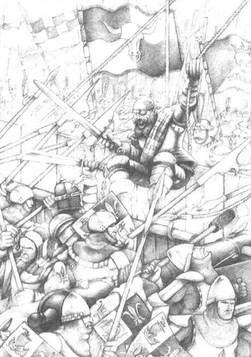
A crew of Imperial buccaneers seeking plunder and adventure
The Imperial Navy is an essential part of the Empire’s military. Not only is it responsible for defending the coasts and trade routes, but it also transports the state armies and local militias wherever they may be needed, acting as a force multiplier and allowing for rapid redeployment of the Empire’s troops. Further, the navy is used to blockade enemy ports, escort merchant convoys, explore distant lands, transport important dignitaries, and for capturing foreign vessels, one of the most lucrative businesses in the Old World. No matter an individual’s skills or capabilities, there will be a place for him in the Navy, and it demands little in return other than hard work, an adventurous nature, and a penchant for grog.[2a]
The Imperial Navy’s stated goals are threefold. Firstly, it protects the coasts, rivers, trade routes, ports, and shores of the Empire. Secondly, it investigates foreign vessels in Imperial water. Lastly, it provides transportation for men and equipment to project the power of the Emperor wherever he deems necessary. Of course, this is a vast simplification of the Imperial Navy’s duties, especially as the northern fleet swears to Grand Baron Gausser, not the Karl Franz, but it is the officially claimed goals. The navy’s motivation is equally simple: It is in the service of an Elector Count, and it is being paid to do a job. Again, this simplifies a complex situation. For example, many young nobles join the navy in the hope of making their fortune with spoils and prizes, not out of any sense of loyalty or for meagre pay — but it is all the motivation a seaman is supposed to need.[2i]
Symbols and Communication
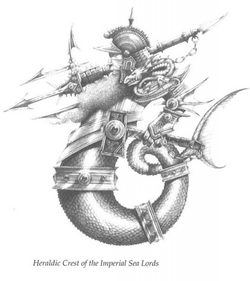
The Heraldric Crest of the Imperial Sea Lords
The Imperial Navy is redolent with different means of communicating information. The two primary methods are flags and pennants, and whistle blasts; however many more techniques exist, especially since the arrival of Imperial Engineers aboard many vessels. Flags and pennants are the most popular method of long-distance communication. Twenty-six square flags are used to represent letters, and ten triangular pennants are used to represent numbers. Beyond signifying numbers and letters, each flag, or combination of flags, also has a pre-determined meaning. The northern fleet also uses a hand-flag semaphore system to communicate messages, actioned by holding an “O” flag in each hand, and positioning the flags in a succession of pre-determined poses, each of which represent a number, letter, or short code.[2i]
Heraldic flags, called ensigns by the navy, are used to provide information about the vessel and its occupants. The ensigns flown usually detail which province the ship is from, whom it represents, and whether there is a Sea Lord or Admiral aboard. Thus, the admiral’s ship is commonly referred to as the flagship, for it flies his heraldic ensign. Where flags are used to communicate at a distance, whistles are used to communicate at short range. All officers, from the Sea Lord down to the lowest petty officer, are given a whistle as a symbol of their authority. Since many of the duties performed on a warship require good rhythm and timing, the Boatswain and the Coxswains use whistles to keep time, with those falling out of time typically receiving a lashing. Further, different combinations of tones and blasts can be used to alert seamen of anything from the captain arriving on the bridge to a warning to all quarters to be ready for an engagement.[2i]
Recruitment and Recruits
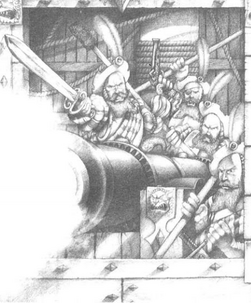
Sailors of the Imperial Navy eager for battle
Contrary to the popular image of the press-gangers clubbing their way through the poor quarters of Altdorf, Marines “on the press” do no such thing. By maritime law, a press-ganged man must be of “seafaring habits and between the ages of 15 and 50”. Thus, most impressed men are merchantmen or occasionally foreign sailors. Of course, sometimes the marines make a mistake, and a butcher or rat catcher will find himself aboard a warship heading out to sea; but, by this time, it’s far too late. In truth, most of a typical ship’s complement is made up of volunteers drawn to the navy life by the promise of regular pay and their own spirit of adventure. As such, the bulk of the Imperial Navy comprises unmarried men between the ages of 18 and 30.[2i]
The greatest responsibility for any naval man is to do his job. For some, this will involve putting out to sea for months at a time. For others, it will involve working as part of the naval support network, perhaps as an innkeeper, a shipwright, a clothmaker, or even a lawyer. For a select few, it may involve working undercover, seeking to further the Navy’s long-term goals by spying on their enemies and gathering information. Whatever the job may be, it needs be done, and that is all. For those who manage to do their jobs, there are many benefits. Primary amongst these is the opportunity to get a fresh start, access to naval missions, and, most importantly of all, prizes.[2j]
Firstly, all new recruits are cleaned, deloused, and clothed, and, after they sign their contract of employment, are guaranteed their wages. Further, they get fed on board, a significant draw for out-of-work men with little chance employment elsewhere. What’s more, there is a network of naval missions down the length of the Reik that provides cheap food, bedding, and entertainment for serving seamen of the Imperial Navy. The missions are very popular, for most seamen appreciate cheap alcohol and rowdy music. However, the greatest benefits open to a serving member of the Imperial Navy is prizes. Any ship legally captured will be sold, along with its contents, upon returning it to port.[2j]
The money earned is supposed to be split amongst the crew and the Admiralty, with the Admiralty taking one eighth, the captain taking a quarter, the master and lieutenants, warrant officers, and petty officers each taking one eighth, and the remaining quarter being split amongst the seaman and marines. So great is the potential haul here, that in the three years the Unerschrocken plied Bretonnian waters in the early 2500s it managed to capture 53 ships as prizes, earning every crewman almost 20 years of pay on top of their normal wages. The captain, Lord Reichen von Telland, retired at the age of 26, and now owns three palaces in Altdorf, one in Nuln, and significant estates in Talabecland. However, if a ship is illegally captured, then the full brunt of the cost is borne by the captain, an end result that can easily turn a man into a pauper if he is not careful.[2j]
Organization
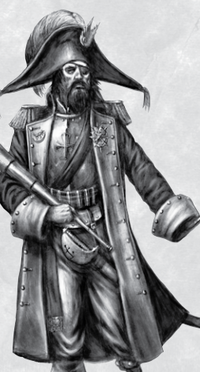
A powerful Imperial Admiral of the Navy
The Imperial navy is split into two fleets: the Imperial First Fleet, based in Reikland, and the Imperial Second Fleet, based in Nordland. To the north, this new, modern fleet, officially titled the Imperial Second Fleet, is operating out of Dietershafen in Nordland. It is not the largest fleet in the Old World, but it is well trained and experienced. To the south, the hoary Imperial First Fleet operates from Altdorf’s Reiksport. It is by far the larger of the two fleets, but the majority of its ships rarely see the sea, for Marienburg’s tolls for war vessels are exorbitantly high. The geographical and ideological differences between the two fleets could hardly be larger. The Nordlanders view the Reiklander fleet as a mess of foppish nobles playing at ships with drunken sailors on old, tatty vessels, and have no respect for them at all. In turn, the Reiklanders see the Nordlanders as barely civilised upstarts with little regard for tradition or sound, military tactics, and, equally, have no respect for them at all. To say they dislike each other would be to seriously understate the differences between them.[2d]
The Imperial Navy employs all manner of folk. At sea, the ships are effectively large floating communities, with some boasting a complement of over a thousand souls, and supporting such numbers as this requires a broad array of skills from all levels of society. Indeed, many ship rosters read like a cross-section of the Empire. Nobles and magisters, Priests and craftsmen, soldiers and servants, and, of course, seamen; everyone is present, and everyone is needed. This is mirrored by the navy’s shore-based establishments. Naval missions employ entertainers, innkeepers, servants, craftsmen, and more. The Admiralty employs a wide array of staff to administrate the navy, and supports it with heralds, servants, stewards, scholars, scribes, and more. And then there are the shipyards, and the quays, and the warehouses, and so many other things. The navy is a massive employer, and it is always recruiting.[2i]
Chain of Command
The Imperial Navy follows a strict structure, and everyone has his place. At the top are the commissioned officers: nobles granted the right to command by an Elector Count. Beneath these are the warrant officers: commoners whose experience and expertise demands special recognition. And lastly, at the bottom of the pile, are the seamen.[2d]
- Empire Sea Lords - each Sea Lord command one fleet. They are Adalmann von Hopfberg for the First Fleet, and Ludolf Köhler for the Second Fleet.[2e]
- Empire Admirals - Admiralscontrol a fleet of ships, generally ranging from 3-12 vessels.[2e]
- Empire Captains - Captains are in control of ships.[2e]
- Empire Lieutenants - Lieutenants are the assistants to a captain.[2f]
- Empire Wardroom Officers - Warrant Officers fulfill important tasks on a ship; most are wizards, priest, navigators, surgeons, or pursers.[2f]
- Empire Standing Officers - Standing Officers fulfill necessary tasks relating to the ship. Most are boatswains, gunners, or carpenters.[2g]
- Empire Lower Officers - Lower Officers do menial tasks and have very little job security. Cooks, caulkers, masters-at-arms, watchmen, ropemakers, and sailmakers are common jobs for a lower officer.[2h]
- Empire Coxswains - Coxswains, also called petty officers, lead small squadrons of seamen.[2h]
- Empire Seamen - Seamen or Sailors are the lowest rank on the ship. They are in charge of small sections of the ship.[2h]
- Empire Marines - Marines are soldiers stationed aboard ships. Marines from the First Fleet are sometimes called "Shipswords" or "River Wardens".[2h]
Warships
There are five main types of ships in the Imperial Navy:
- Empire Greatships - The largest Imperial vessels in service, the mighty Greatship is a great floating arsenal bristling with guns and packed with heavily armed Empire soldiers.[1a]
- Empire Wolfships - The sleek Woflship is the most powerful Imperial ship of the line. Hunting in packs and armed with great batteries of cannon which jut from its forecastle, it uses its titanic ram to sprear the foes into splinter.[1a]
- Empire Wargalleys - Wargalleys are swift-moving, lightly-armed ramships used for patrolling the River Reik and the Empire's northern coastline.[1a]
- Empire Hellhammers - A variant of the Wargalley outfitted with an enormous Siege Cannon on its fore-deck.[3a]
